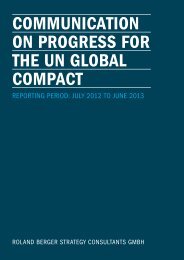PDF, 2492 KB - Roland Berger Strategy Consultants
PDF, 2492 KB - Roland Berger Strategy Consultants
PDF, 2492 KB - Roland Berger Strategy Consultants
- No tags were found...
You also want an ePaper? Increase the reach of your titles
YUMPU automatically turns print PDFs into web optimized ePapers that Google loves.
Study 7f1Global R&D spending is projected to rise in 2012 by about 5.2%to reach more than USD 1.4 trillion, slightly below the 6.5%increase in 2011 after the global recession and governmentR&D incentives.The global R&D landscape is changing. Emerging markets areadvancing from production sites and work benches to becomeimportant innovation hubs: Many emerging countries havenot only increased R&D investments but also moved up theglobal innovator leagues tables.Most notably, over the last few years China and India substantiallyboosted their share of global R&D spending. Between 2007 and2012 they doubled their spending from USD 100 to 200 billion(China) and USD 21 to 40 billion (India). These two countries nowaccount for almost 20% of global R&D spending.Focus 20 country developmental priorities currently limit totalresources dedicated to research, but R&D spending will rise astheir economies grow. Indeed, some emerging market companiesalready allocate considerably higher percentages of revenue toresearch than national averages. One result is that five Focus 20companies from China, India and Brazil now rank among the Top20 of Forbes 2011 Most Innovative Companies. In 2010, 44 of the1,000 biggest technology companies (in terms of R&D spending)were headquartered in emerging markets, more than doublethe 16 enterprises cited five years earlier. Chinese and Hong Kongcompanies represent most of these high spenders, followed byIndian and Brazilian companies.Skilled people are, of course, a precondition to boosting innovativeperformance and several emerging markets are enjoying a braingain as the number of young skilled workers increases. For ex ample,between 2004 and 2011 the BRIC student population grew bymore than 7% annually, while large European countries such asGermany saw student enrollments increase by only 2%. Theavailability of researchers and engineers, especially across Asiaand Africa/Arabia, is also improving. Between 2004 and 2007,Chinese engineering graduates doubled from 1 to 2 million, whilein Iran and Saudi Arabia the number of engineers expanded threeto fivefold. But it should also be noted that across many emergingcountries educational quality remains a concern as educationalinstitutions invest to improve standards.intellectual property. According to the World Economic Forum,China, Saudi Arabia, Malaysia and South Africa very successfullyaffirm the intellectual property rights of foreign investors.Unfortunately countries such as India or Indonesia are still lowperformers regarding intellectual property protection.F1Emerging markets' shares of worldR&D budget are increasingShare of global R&D spending 4 (USD bn, %)2.0%9.5%13.5%25.9%US Europe ChinaJapan2007India∑ USD 1,058 bn∑ USD 1,403 bn2.9% +0.9%-pts.+4.7%-pts.14.2%11.2%-2.3%-pts.24.1%34.3% 31.1%2012-1.8%-pts.-3.2%-pts.f2One indicator of a country's evolution toward higher "informationsociety" economic development are legal protections granted toSource: Batelle4) Gross domestic expenditure on R&D
















